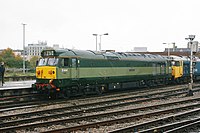Difference between revisions of "BR Class 50 50044 Exeter"
(Create page for 50044 Exeter) |
(correction) |
||
| Line 1: | Line 1: | ||
| − | [[File:Hugh llewelyn D444 (5581607177).jpg|thumb|200px|right| D444 (50044 | + | [[File:Hugh llewelyn D444 (5581607177).jpg|thumb|200px|right| D444 (50044 Exeter) (Wikimedia Commons)]] |
==BR Class 50== | ==BR Class 50== | ||
Fifty English Electric Type 4 (later BR Class 50) diesel locomotives were built by English Electric at their Vulcan Foundry Works plant in Newton-le-Willows between 1967 and 1968. When built they were numbered in the D4xx series. They later became BR’s Class 50, being allocated TOPS numbers in the 50xxx series. The class was nicknamed “Hoovers” because of the distinctive sound of the inertial air-filters with which the locomotives were originally fitted. | Fifty English Electric Type 4 (later BR Class 50) diesel locomotives were built by English Electric at their Vulcan Foundry Works plant in Newton-le-Willows between 1967 and 1968. When built they were numbered in the D4xx series. They later became BR’s Class 50, being allocated TOPS numbers in the 50xxx series. The class was nicknamed “Hoovers” because of the distinctive sound of the inertial air-filters with which the locomotives were originally fitted. | ||
Revision as of 21:59, 5 December 2015
BRBritish Rail or British Railways Class 50
Fifty English Electric Type 4The British Railways classification for diesel locomotives of 2000 bhp to 2999 bhp (later BRBritish Rail or British Railways Class 50) diesel locomotives were built by English Electric at their Vulcan Foundry Works plant in Newton-le-Willows between 1967 and 1968. When built they were numbered in the D4xx series. They later became BRBritish Rail or British Railways’s Class 50, being allocated TOPSTotal Operations Processing System, an American computer system adopted by BR from the late 1960s to number and manage rolling stock. numbers in the 50xxx series. The class was nicknamed “Hoovers” because of the distinctive sound of the inertial air-filters with which the locomotives were originally fitted.
Initially the locomotives were used to haul express passenger trains on the West Coast Main Line (WCML) between Crewe and Scotland; that section not then being electrified. This often entailed ‘Multiple Working’, with two locomotives under control of a single driver.
By 1974 the northern WCML had been electrified, and the Class 50 fleet was being transferred to BRBritish Rail or British Railways’s Western Region to work main line passenger services out of London Paddington.
The Class 50’s did not originally carry names, but in the late 1970s BRBritish Rail or British Railways agreed to their being named after Royal Navy vessels with notable records in the First and Second World Wars.
Withdrawal of the class began in the early 1990s.
50044 Exeter in Service
D444 entered service at Stoke in November 1968, having been built as English Electric Works No 3814/D1185.
In May 1973 D444 was transferred to Crewe, being re-numbered 50044 in February 1974. Following electrification of the WCML, 50031 moved to Bristol in May 1974, before a move to Plymouth Laira in November 1980.
In April 1978, 50044 was named Exeter after HMS Exeter, a Royal Navy World War York Class Cruiser. Commissioned in 1931, HMS Exeter was involved in the Battle of the River Plate which resulted in the sinking of the German battleship Graf Spee. HMS Exeter was later sent to the East Indies where she was sunk by the Japanese in 1942.
50044 was withdrawn from service by BRBritish Rail or British Railways in January 1991.
50044 Exeter in Preservation
Following withdrawal, 50044 was sent to London’s Stratford depot for component recovery and later offered for sale as suitable for scrap only. The Fifty Fund were seeking a locomotive as a source of spares, but finding that few components had been removed, successfully purchased 50044 for preservation. Since then 50044 has worked both on the SVRSevern Valley Railway and on the main line.
Links
Class 50 Alliance web site
50 Fund web site (still maintained)
